The search landscape has fundamentally shifted since 2024. According to research from Forbes Advisor and Talker Research, 46% of Generation Z and 35% of millennials prefer social media over traditional search engines for finding information. Meanwhile, Google’s AI Overviews now appear for 10.4% of U.S. desktop keywords—a new high as of March 2025, and experienced a significant 119% increase in frequency on mobile during the same period.
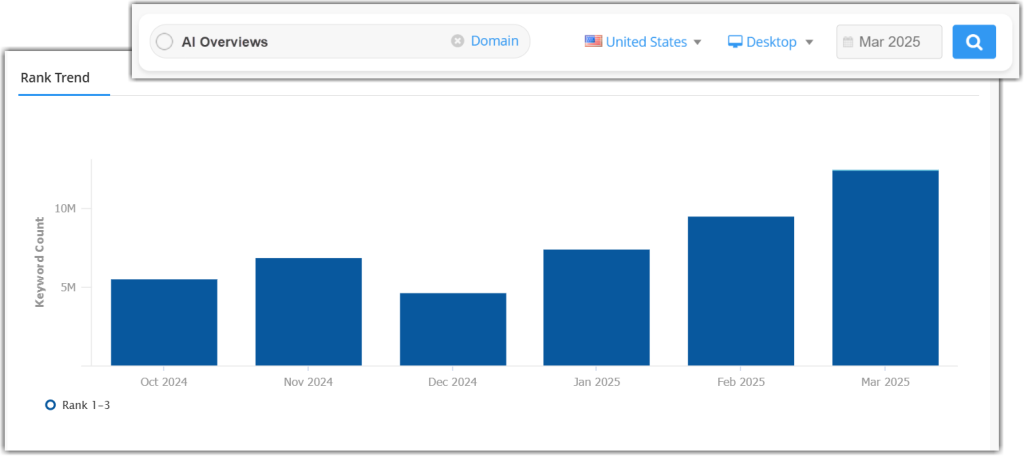
We’re competing for visibility across a multi-platform, AI-driven ecosystem that spans Google’s AI Overviews, TikTok’s discovery engine, Instagram’s search function, and emerging AI assistants. This guide offers a comprehensive roadmap to dominate organic traffic in this new reality.
What is Organic Traffic
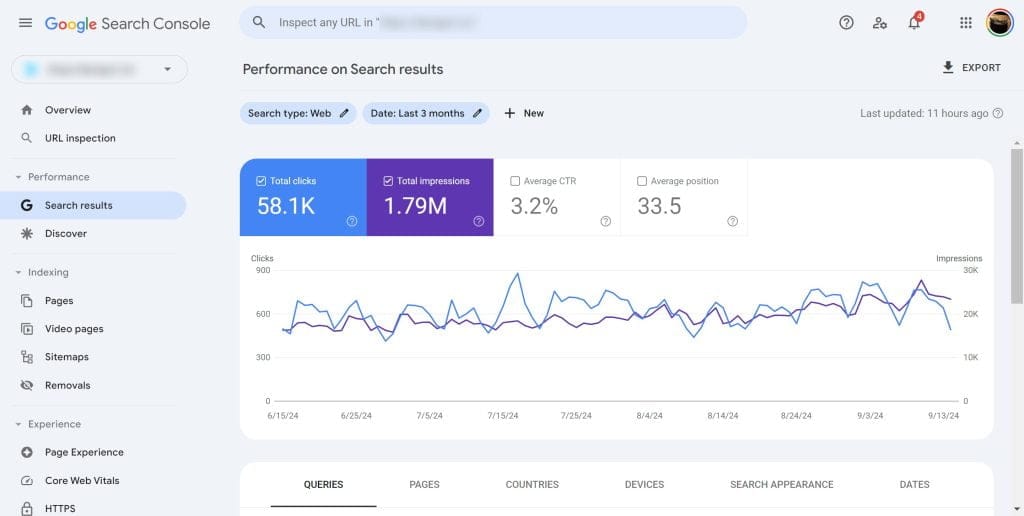
Organic traffic still refers to visitors who find your website through unpaid search results, but the sources have dramatically expanded. Today’s organic traffic comes from traditional Google Search (now includes AI Overviews), AI Mode (Google’s conversational search experience powered by Gemini 2.5), social search platforms like TikTok, Instagram, and Pinterest, voice assistants including Alexa, Siri, and Google Assistant, and answer engines such as ChatGPT and Claude.
The fundamental shift centers on user behavior. A comprehensive SparkToro study found that nearly 60% of Google searches now result in zero clicks, meaning users find their answers without visiting websites.
Specifically, for every 1,000 Google searches in the US, only 360 clicks go to non-Google properties. Your content might be seen, summarized, and referenced without generating a click, but that visibility still drives brand awareness, authority, and indirect conversions.
SEO Evolution: Traditional vs Today’s Approach
Traditional SEO
Today’s SEO Approach
Why Your Agency Needs to Understand These Changes for Client Success
The metrics that mattered in 2024 have evolved significantly. Visibility matters more than clicks when your content appears in AI Overviews or social search results. Brand mention tracking has become crucial as authority gets measured by citations across AI responses.
Cross-platform attribution helps you understand users who discover you on TikTok and convert through Google. Intent matching drives success because AI prioritizes content that precisely matches user intent across the journey.
Why Organic Traffic Still Delivers the Best ROI Despite All the Changes
Despite the changes, organic traffic remains the most cost-effective channel with measurable advantages:
Cost Benefits That Still Make Organic Traffic Worth the Investment
Organic search accounts for 53% of all website traffic, making it 5x more cost-effective than paid advertising when accounting for long-term value. While AI Overviews might reduce clicks initially, they often generate higher-quality traffic from users with specific intent.
Conversion Rates That Outperform Most Other Traffic Sources
According to multiple industry studies, organic search typically delivers conversion rates between 2.7% to 3.75%, which often outperforms paid search in many industries. Users coming from organic search convert better because they’re actively seeking solutions rather than being interrupted with ads.
Authority Growth That Compounds Across All Platforms
Unlike paid ads, your organic authority compounds across platforms. A well-optimized piece can drive traffic from Google, get cited in AI responses, trend on TikTok, and be discovered on Instagram, all from one piece of content.
B2B Revenue Numbers That Prove Organic Search Dominance
B2B businesses generate twice as much revenue from organic search than all other digital channels combined, with organic search driving 44.6% of all revenue for B2B companies.
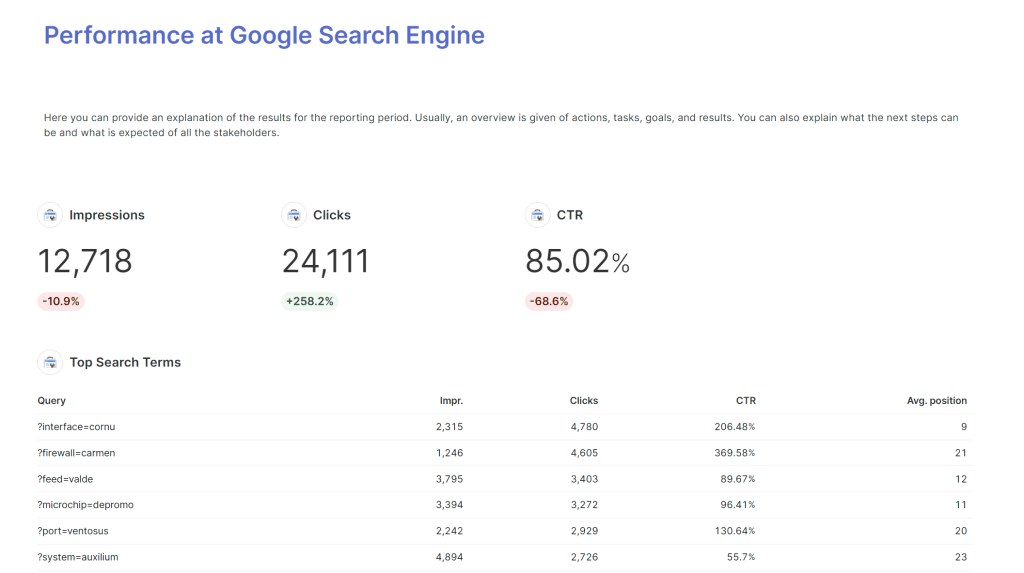
The 8 Core Strategies That Actually Work for Organic Success in 2025
Success in 2025 requires a comprehensive approach that addresses both traditional SEO fundamentals and emerging technologies. These eight strategies work together to create sustainable organic growth across all platforms where your audience searches for information.
Ready to dive in?
1. E-E-A-T Requirements That Google Actually Cares About in the AI Era
Google’s focus on Experience, Expertise, Authoritativeness, and Trustworthiness has intensified as AI systems become better at evaluating content quality. Google’s March update penalized 87% of YMYL sites lacking first-hand expertise, making these signals essential for ranking success.
How to Demonstrate Real Experience That Google Recognizes
Document real case studies with measurable outcomes. Include behind-the-scenes content showing your process. Add author bylines with relevant experience credentials. Showcase user-generated content and testimonials that demonstrate real-world application.
Expertise Signals That Separate You from Competitors
Create comprehensive, data-backed resources that showcase deep knowledge. Publish original research and industry insights that establish thought leadership. Include certifications and qualifications prominently on author pages. Collaborate with recognized industry experts to build credibility.
Authority Markers That Search Engines and Users Trust
Secure high-quality backlinks from authoritative sources in your industry. Get mentioned in industry publications and podcasts that matter to your audience. Speak at conferences and share the content across your channels. Build relationships with other experts in your field through meaningful collaboration.
Trust Factors That Convert Visitors into Customers
Display clear contact information and company details that visitors can verify. Include privacy policies and terms of service that demonstrate transparency. Showcase security certificates and compliance badges relevant to your industry. Maintain consistent NAP (Name, Address, Phone) across all platforms and directories.
2. AI and SEO
Creating content that AI systems understand and reference requires a fundamentally different approach than traditional SEO writing. Keywords that trigger AI Overviews tend to be slightly longer in word count, and more likely to include clarifications, comparisons, or definitions—classic informational query shapes that serve user intent.
Content Structure That AI Systems Can Easily Parse and Reference
Structure content with clear, scannable sections that AI can easily parse and reference. Use descriptive headers that answer specific questions your audience asks. Include data, statistics, and quotable insights that provide unique value. Create comprehensive guides that AI systems can reference with confidence.
Zero-Click Optimization Techniques That Still Drive Brand Awareness
Front-load key information in the first paragraph to capture immediate attention. Use bullet points and numbered lists for easy extraction by AI systems. Include schema markup for enhanced visibility in search results. Create FAQ sections that directly answer common queries in your industry.
Multi-Format Content Approach That Reaches Every User Preference
Repurpose written content into video, audio, and visual formats that serve different user preferences. Create step-by-step tutorials that work across platforms and devices. Develop interactive content like calculators and tools that provide immediate value. Design infographics that summarize complex information in digestible visual formats.
For example, you might be targeting “social media marketing” as a keyword. AI tools could reveal that “social media marketing for small businesses” is a less competitive, more specific keyword that could bring in qualified leads.
3. Social Search Optimization That Captures Gen Z and Millennial Audiences
Social platforms have evolved into full-featured search engines, particularly for younger demographics. Research shows that 46% of Generation Z prefer searching on social and video platforms over traditional search engines, making social optimization essential for modern organic strategies.
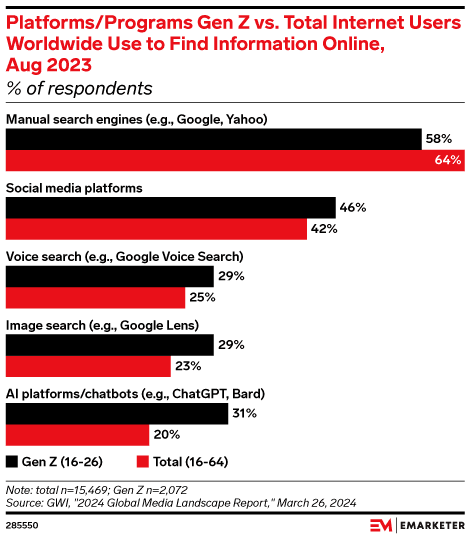
We sat down with Alexandre Hoffmann, Managing Partner of Organic Marketing Growth and Innovation at Passion Digital to elaborate on how he approaches content ideation to creation:
The most significant change in SEO for me is social search and the increase in the variety of content formats… It makes our jobs a lot harder, as you are not only dealing with writers and developers anymore. Your strategies need to be a lot more rounded, and they tend to cost a lot more money.
I would approach this by really looking at the different platforms and the results that appear for different queries, the type of content, the engagement… You can also analyze hashtags or the search volume of queries on different platforms to see if it’s even worth it to create a blog post, for example.
Another good way to gauge if written content is enough is to look at the SERPs, what ranks? Blog posts or videos from social media platforms? That’s a great indicator of what users want to see. Don’t spend time and money writing a 3,000-word blog post if 80% of the SERPs are images and YouTube videos.
You can read the entire interview with Hoffman on Linkedin Pulse.
TikTok SEO Tactics That Get Your Content Discovered
Use natural language keywords in captions and voiceovers that match how people actually speak and search. TikTok’s voice recognition technology now plays a key role in its search algorithm, making audio optimization crucial. Create content around trending topics with your unique angle and expertise. Use specific hashtags alongside broader ones to maximize discovery. Add location tags for local discovery and community building. Utilize TikTok’s Creator Search Insights for keyword research and trend identification.
Instagram Optimization Methods That Work with the New Search Integration
Since July 10th 2025, all public content from professional Instagram accounts can appear in search engine results by default, making Instagram SEO crucial for organic visibility. Optimize captions with relevant keywords that your audience searches for. Use alt text for images with descriptive, keyword-rich content that serves both accessibility and SEO. Create searchable Reels with trending audio and hashtags that align with your brand. Maintain consistent posting schedule for algorithm favor and audience engagement. Utilize Instagram’s category and location features to improve discoverability.
Cross-Platform Strategies That Maintain Brand Consistency
Maintain consistent brand messaging across all platforms while adapting to each platform’s unique culture. Adapt content formats while preserving core message and brand voice. Track performance across platforms for attribution and optimization insights. Create platform-specific content while maintaining brand voice and values.
Reddit Optimization Methods That Capture High-Intent Community Traffic
Reddit has become increasingly important for search visibility, with Google featuring Reddit content prominently in search results. Focus on providing genuine value in relevant subreddits rather than promotional content. Build authority by consistently answering questions and sharing expertise in your industry communities. Use Reddit’s search function to identify popular topics and questions in your niche. Create comprehensive posts that serve as resources for community members, as these often get linked to and referenced outside of Reddit.efore your users do.
4. Technical SEO Updates That Actually Impact Rankings in 2025
Technical SEO remains the foundation that enables all other strategies to work effectively. While the fundamentals haven’t changed dramatically, the standards have become more stringent and the impact of technical issues more severe as competition increases.
Core Web Vitals Standards That You Must Meet
The metrics remain the same, but standards continue to evolve with user expectations. LCP (Largest Contentful Paint) should stay under 2.5 seconds, INP (Interaction to Next Paint) should remain under 200 milliseconds for a “good” experience, and CLS (Cumulative Layout Shift) must stay under 0.1 for visual stability.
AI Crawler Optimization Steps That Help Search Engines Understand Your Content
Implement comprehensive schema markup that helps AI understand your content context. Create clean, semantic HTML structure that search engines can easily parse. Optimize for voice search with conversational content that matches natural speech patterns. Make sure mobile-first responsive design that works across all devices. Use structured data for enhanced understanding by AI systems.
For larger sites, managing crawl budget is key. Use these techniques:
- Guide crawlers with robots.txt
- Set up pagination correctly
- Avoid duplicate content
- Fix broken links and redirect chains
This helps search engines find and index your most important pages efficiently.
Performance Improvements That Directly Affect User Experience
Minimize JavaScript execution time to improve page responsiveness. Implement lazy loading for images and videos to speed up initial page loads. Use next-gen image formats (WebP, AVIF) for faster loading times. Optimize for Core Web Vitals on mobile devices where most users browse. Implement proper caching strategies to reduce server response times.
5. Content Strategies That Work Across Multiple Platforms and Customer Journey Stages
Modern content strategy requires understanding how users move between platforms and touchpoints throughout their journey. Success comes from creating content that serves different intents while maintaining consistent messaging and brand voice across all channels.
Intent-Based Content Creation That Matches User Needs at Every Stage
Map content to different stages of the user journey from awareness to conversion. Create content that answers specific questions your audience asks at each stage. Develop topic clusters around your expertise areas that establish authority. Use real user questions from support tickets and social media as content inspiration.
Chris Meabe, Senior Content Specialist at Foundation Marketing was asked “How do you approach keyword research for long-term content relevance?” during our interview. And he came up with a great suggestion:
It’s similar to any other keyword research you would do, but you’ll want to pay more attention to how volatile the SERPs are and how certain SERP competitors are staying on top of some keywords but not others.
Read the full Linkedin interview with Chris Meabe
Original Research and Data Approaches That AI Cannot Replicate
Websites that publish original research, proprietary data, and industry reports can offer something AI simply cannot replicate or summarize effectively.
Conduct industry surveys and publish results that become reference points. Analyze trends in your niche with proprietary data that competitors cannot access. Create annual reports that become industry references and citation sources. Develop case studies with measurable outcomes that demonstrate real-world success.
Multimedia Content Development That Serves Different Audience Preferences
Create video content for YouTube, TikTok, and Instagram that serves different audience preferences. Develop podcast content for audio platforms that busy professionals can consume while multitasking. Design interactive tools and calculators that provide immediate value to users. Build comprehensive resource libraries that become go-to destinations for your industry.
Google often displays video results, especially for “how-to” queries. Add video schema markup to your embedded videos to increase your chances of appearing in these results. Keep track of all your growth with our YouTube report template.
6. Link Building Approaches That Survive Algorithm Updates and Build Real Authority
Link building in 2025 requires a complete shift from quantity-focused tactics to relationship-based strategies that create genuine value. Quality over quantity has never been more important, as Google’s March Core Update addresses low-quality content and introduces new policies on spam to combat manipulative practices.
As Hinde Lamrani, Digital Marketing Services Director at Acolad group points out,
Global Marketing Campaigns target specific audiences, so the Localized version of the campaign needs to be tailored for the target audience in the target international markets for better ROI. Companies need to choose the right localization process; for example, choosing machine translation or traditional human translation will not work for Global Marketing campaigns.
Instead of simple translation, you need to adapt your content with a deeper understanding of local nuances.
| Aspect | Consideration |
|---|---|
| Language | Use native speakers for translation |
| Cultural references | Adapt to local culture and customs |
| Search behavior | Research local keyword trends |
They need to choose Transcreation as a localization process. Transcreation is the process during which a highly specialized linguist recreates the source text to be appropriate for the target audience — NOT a direct translation… As opposed to a translator, a transcreator is allowed to not adhere strictly to the source text; this freedom facilitates their work so they CAN make changes to make sure cultural differences are respected.
Read our entire interview with Hinde Lamrani here.
Authority-Based Link Acquisition That Focuses on Quality Over Quantity
Focus on links from sites with strong E-E-A-T signals in your industry. Prioritize contextual links within relevant content that provides value to readers. Build relationships with industry publications that your audience trusts and reads regularly. Create linkable assets like research studies and tools that naturally attract high-quality backlinks.
Content-Driven Link Building That Attracts Natural Backlinks
Develop comprehensive guides that naturally attract links from other content creators. Create industry reports that become citation sources for journalists and researchers. Publish research that other sites want to reference and build upon. Build tools and resources that provide genuine value to your industry community.
Digital PR Integration That Connects Your Expertise to News Cycles
Connect breaking news to your expertise and provide timely commentary. Offer expert commentary on industry developments that journalists need for their stories. Create newsworthy studies and surveys that generate media coverage. Build relationships with journalists and influencers who cover your industry regularly.c topics or keywords. Optimize your profile and board descriptions with relevant keywords to improve your visibility in platform-specific searches.
7. Local SEO Tactics That Drive Foot Traffic and Local Conversions
Local SEO has become more sophisticated and competitive as businesses recognize its impact on both online and offline conversions. Success requires a comprehensive approach that goes beyond basic directory listings to build genuine community connections and local authority.
Google Business Profile Optimization That Actually Gets You Found
Maintain complete, accurate business information that potential customers can trust. Post regular updates and announcements about your business activities. Respond to all reviews promptly and professionally to build customer relationships. Add high-quality photos and videos regularly to showcase your business personality.
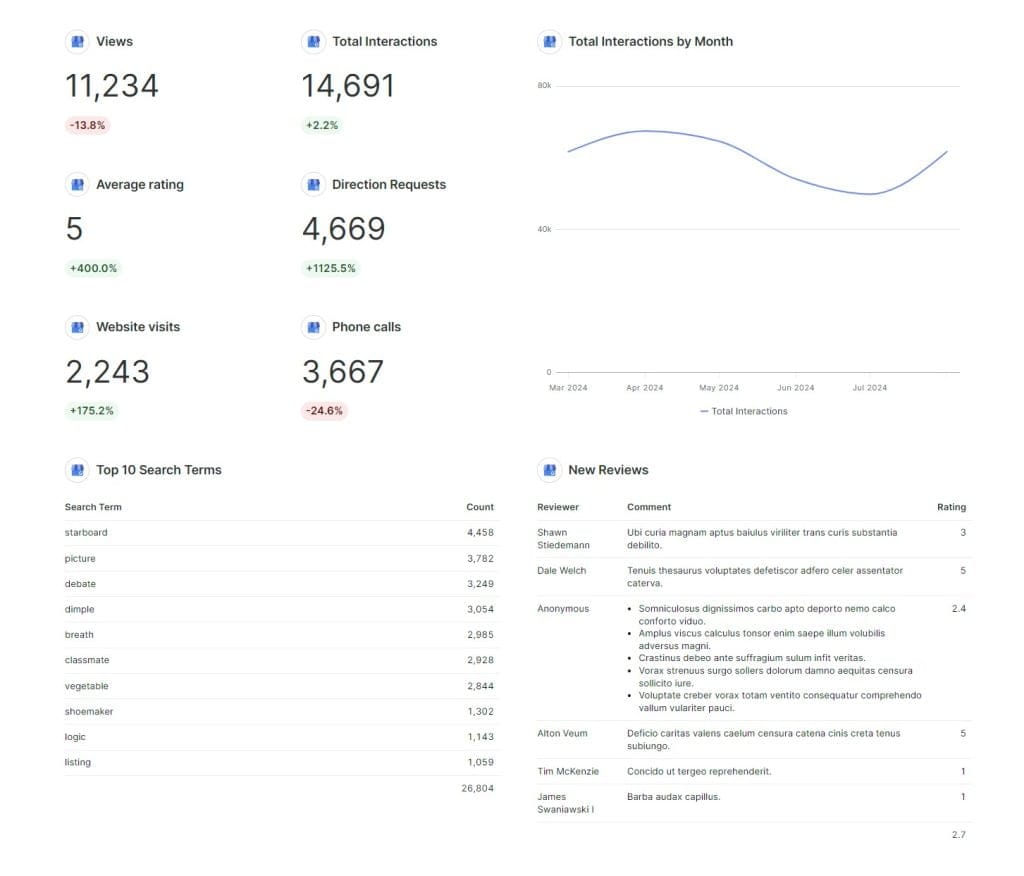
Local Content Development That Establishes Community Authority
Create location-specific landing pages that serve different geographic markets. Develop content about local events and community involvement that builds local authority. Build citations in relevant local directories that your customers actually use. Engage with local businesses and organizations to build community connections.
Review Management Systems That Build Trust and Handle Negative Feedback
Implement systematic review generation strategies that encourage satisfied customers to share their experiences. Respond to all reviews, positive and negative, with genuine care and professionalism. Use review insights to improve products and services based on customer feedback. Monitor review mentions across all platforms to maintain your online reputation.eet both user needs and search engine requirements.
8. Analytics and Measurement Frameworks That Track Success Across All Channels
Traditional analytics fall short in capturing the complexity of modern search behavior. You need measurement frameworks that account for cross-platform journeys, brand awareness building, and the growing importance of zero-click visibility.
Multi-Platform Attribution Methods That Show the Complete Customer Journey
Track brand mentions across AI responses to understand your authority impact. Monitor visibility in AI Overviews and social platforms to gauge reach. Measure cross-platform user journeys to understand the complete customer experience. Analyze indirect traffic from brand searches to assess awareness building.
Key Performance Indicators That Actually Matter in 2025
- Visibility Score: Appearances across search platforms and comprehensive reach measurement
- Brand Mention Velocity: Rate of brand citations and authority building across platforms
- Cross-Platform Engagement: Interactions across channels to understand audience behavior
- Attribution Modeling: Multi-touch conversion paths to optimize budget allocation
Tool Recommendations That Give You Actionable Data
Google Search Console provides essential data for traditional search performance. Brand monitoring tools track AI citations and mentions across the web. Social media analytics platforms offer platform-specific insights for optimization. Attribution modeling software helps you understand cross-channel customer journeys.e Search Console to ensure it’s found and indexed.

Want to see what’s coming next? AI can help with that too. It can forecast traffic trends and spot potential drops before they happen.
Set up AI-powered alerts in your analytics tool to notify you of unusual patterns. If your traffic usually dips in the summer, AI can help you prepare content to counteract that trend.
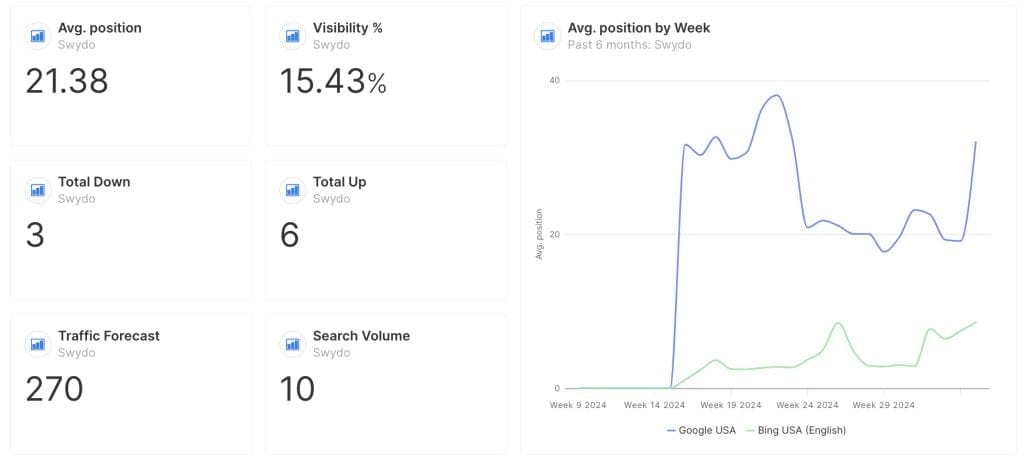
Industry-Specific Strategy Effectiveness That Helps You Prioritize Resources
Different industries see varying levels of success with each strategy, making it crucial to understand where to focus your efforts based on your clients’ sectors. This data helps you allocate resources more effectively and set realistic expectations for results.
Organic Traffic Strategy Effectiveness by Industry
| Strategy / Industry | E-commerce | B2B Services | Media | Healthcare | Tech |
|---|---|---|---|---|---|
| Content Marketing | High | Very High | Very High | High | Very High |
| Technical SEO | Very High | High | High | High | Very High |
| Link Building | High | Very High | High | Medium | High |
| Local SEO | Medium | High | Low | Very High | Medium |
| Video SEO | High | Medium | Very High | Medium | High |
| Voice Search Optimization | Medium | Low | Medium | High | High |
What to Expect for Organic Traffic Trends Through 2025 and Beyond
The pace of change in search continues to accelerate, driven by AI advancement, changing user behavior, and platform evolution. Understanding these trends helps you prepare for shifts before they impact your clients’ results.
AI Integration Developments That Will Change How Search Works
More sophisticated AI Overviews will integrate multimedia content seamlessly. Voice search will become mainstream for complex queries and research. AI assistants will provide more detailed, cited responses that include attribution.
Platform Convergence Trends That Blur the Lines Between Search and Social
Social platforms will develop into full search engines with advanced capabilities. Traditional search engines will integrate social signals for better results. Cross-platform content discovery will become the standard user experience.
User Behavior Changes That Will Affect Your Content Strategy
Users will have increasing expectations for immediate, accurate answers to their questions. Growing preference for multimedia content consumption will shape how information gets packaged. Rising importance of personal recommendations and social proof will influence purchase decisions.
Your Step-by-Step Action Plan to Implement These Strategies Today
Implementation requires a systematic approach that builds on existing strengths while incorporating new strategies. This action plan helps you prioritize efforts and measure progress effectively.
- Audit Current Performance: Assess your visibility across all platforms to understand your starting point
- Develop AI-First Content: Create comprehensive, citable resources that AI systems can reference
- Optimize for Social Search: Establish presence on TikTok and Instagram with strategic content
- Enhance E-E-A-T Signals: Build authority through expertise demonstration and credible partnerships
- Implement Technical Optimizations: Ensure Core Web Vitals compliance across all devices
- Monitor and Adapt: Track performance across all channels and adjust strategies based on data
To keep track of your SEO metrics and progress, tools like Swydo can make reporting and monitoring your organic efforts seamless. Swydo is a client reporting tool designed for marketing agencies, making it easy to build comprehensive SEO reports within minutes.
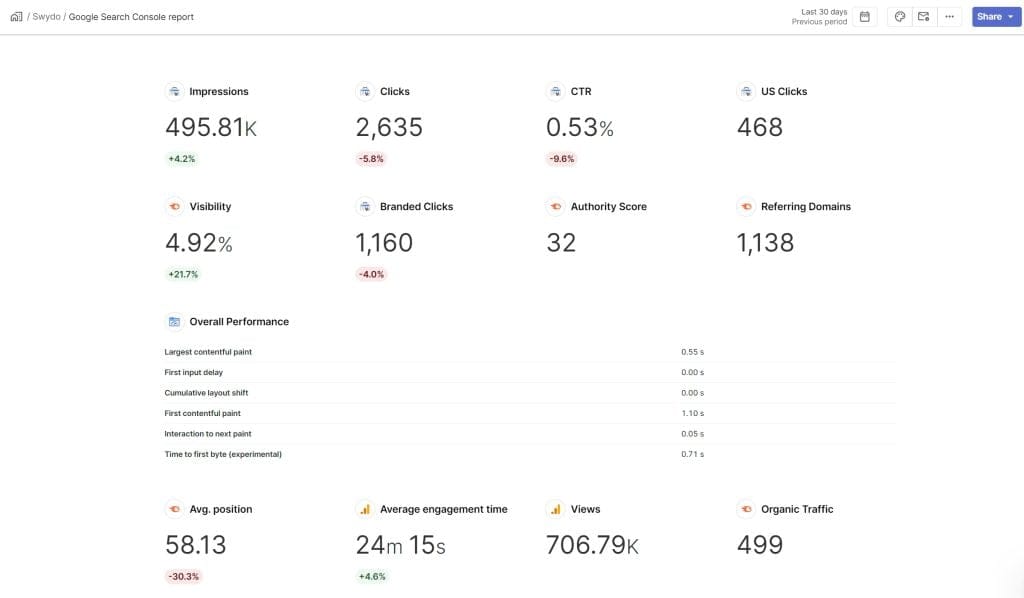
With its KPI monitoring and alerting features, you can ensure your SEO efforts are aligned with your clients’ goals. Plus, Swydo’s stunning data visualizations make it easy to showcase your organic growth in a way that clients can quickly understand and appreciate.
Align your client’s SEO initiative with Swydo from the start. Request a demo or sign up for a free 14-day trial today.
Organic Traffic FAQ
Direct answers to your most searched SEO questions
Organic traffic is visitors who find your website through unpaid search results on Google, Bing, social media platforms, or AI assistants. Unlike paid ads, you don’t pay for these clicks directly.
SEO typically takes 3-6 months to show significant results for new content. Established websites with good authority may see improvements in 1-3 months. Technical fixes can show results within weeks.
Yes. Organic search accounts for 53% of all website traffic and costs 5x less than paid advertising long-term. Organic traffic also converts better because users actively seek solutions rather than being interrupted.
E-E-A-T stands for Experience, Expertise, Authoritativeness, and Trustworthiness. Google uses these signals to evaluate content quality, especially for health, finance, and safety topics.
Basic technical SEO helps significantly. Focus on page speed, mobile optimization, and fixing broken links. Many issues can be identified through free tools like Google Search Console and PageSpeed Insights.
Zero-click searches happen when users get their answer directly from the search results page without clicking any website. Nearly 60% of Google searches now end this way due to AI summaries and featured snippets.
Use clear headers, include specific data and statistics, create comprehensive guides, and structure content in easy-to-scan sections. AI systems prefer content that directly answers questions with supporting evidence.
AI is transforming Google search rather than replacing it. Google integrates AI directly into search results through AI Overviews and enhanced features, but traditional search results remain important for most queries.
Focus on adaptation rather than worry. Create original content that AI cannot replicate, such as personal experiences, proprietary research, and industry insights. AI tools often drive more specific searches to authoritative sources.
Build authority through consistent, high-quality content, earn backlinks from reputable sources, and become a go-to resource in your niche. AI systems prefer citing established, trustworthy sources with proven expertise.
Common causes include algorithm updates, increased competition, technical issues, content becoming outdated, or changes in user search behavior. Check Google Search Console for specific insights and error reports.
Fix technical issues first (page speed, mobile optimization, broken links), optimize existing high-performing content, target long-tail keywords with less competition, and improve your content’s user experience and readability.
How-to guides, tutorials, comparison articles, and comprehensive resources that answer complete user questions perform best. Content that matches search intent and provides unique value consistently attracts organic traffic.
Focus on one primary keyword and 2-3 related secondary keywords per page. Modern SEO prioritizes topic relevance over keyword density, so create comprehensive content around a central theme.
Yes, quality backlinks remain crucial for SEO success. Focus on earning links from authoritative, relevant websites through valuable content, digital PR, and building genuine relationships rather than buying links.
Absolutely. Updating old content with current information, better optimization, and improved user experience can significantly boost rankings. Prioritize posts that already receive some traffic or rank on page 2.
Google Search Console (essential), Google Analytics, PageSpeed Insights, and Google Keyword Planner provide comprehensive basic SEO insights. Ubersuggest and AnswerThePublic offer additional keyword research capabilities.
Core Web Vitals measure user experience: LCP (loading speed – under 2.5 seconds), INP (interactivity – under 200ms), and CLS (visual stability – under 0.1). These directly impact search rankings.
Use Google Analytics to track organic sessions, pages per session, and conversion rates. Google Search Console shows which keywords drive traffic and your average position. Monitor both traffic quantity and quality.
Focus on organic traffic growth, keyword ranking improvements, conversion rate from organic traffic, brand mention velocity, and visibility across multiple platforms rather than just traditional website clicks.
Check Google Search Console weekly for technical issues and indexing problems. Review comprehensive SEO metrics monthly. Track daily fluctuations only during algorithm updates or after major site changes.
Organic traffic typically converts between 2.7% to 3.75% across industries. B2B services often see higher rates (3-5%), while e-commerce varies widely (1-4%) depending on industry and product price points.
Track organic traffic performance across all platforms and prove ROI to your clients with comprehensive SEO reporting.
Start Your Free Trial Today- What is Organic Traffic
- Why Organic Traffic Still Delivers the Best ROI Despite All the Changes
- The 8 Core Strategies That Actually Work for Organic Success in 2025
- What to Expect for Organic Traffic Trends Through 2025 and Beyond
- Your Step-by-Step Action Plan to Implement These Strategies Today
- Organic Traffic FAQ

Use natural keywords in your captions and voiceovers, create content around trending topics with your unique angle, and post consistently. TikTok’s algorithm favors engagement, so focus on creating valuable, shareable content.
Yes, since July 2025, professional Instagram accounts can appear in Google search results by default. Optimize your captions with relevant keywords and use descriptive alt text for images to improve visibility.
Yes, Reddit content appears frequently in Google search results. Participate authentically in relevant subreddits by answering questions and sharing expertise. Avoid promotional content and focus on providing genuine value.
Focus on where your audience searches for information. Gen Z uses TikTok and Instagram, professionals use LinkedIn, and Reddit serves niche communities. YouTube remains important for all demographics and topics.